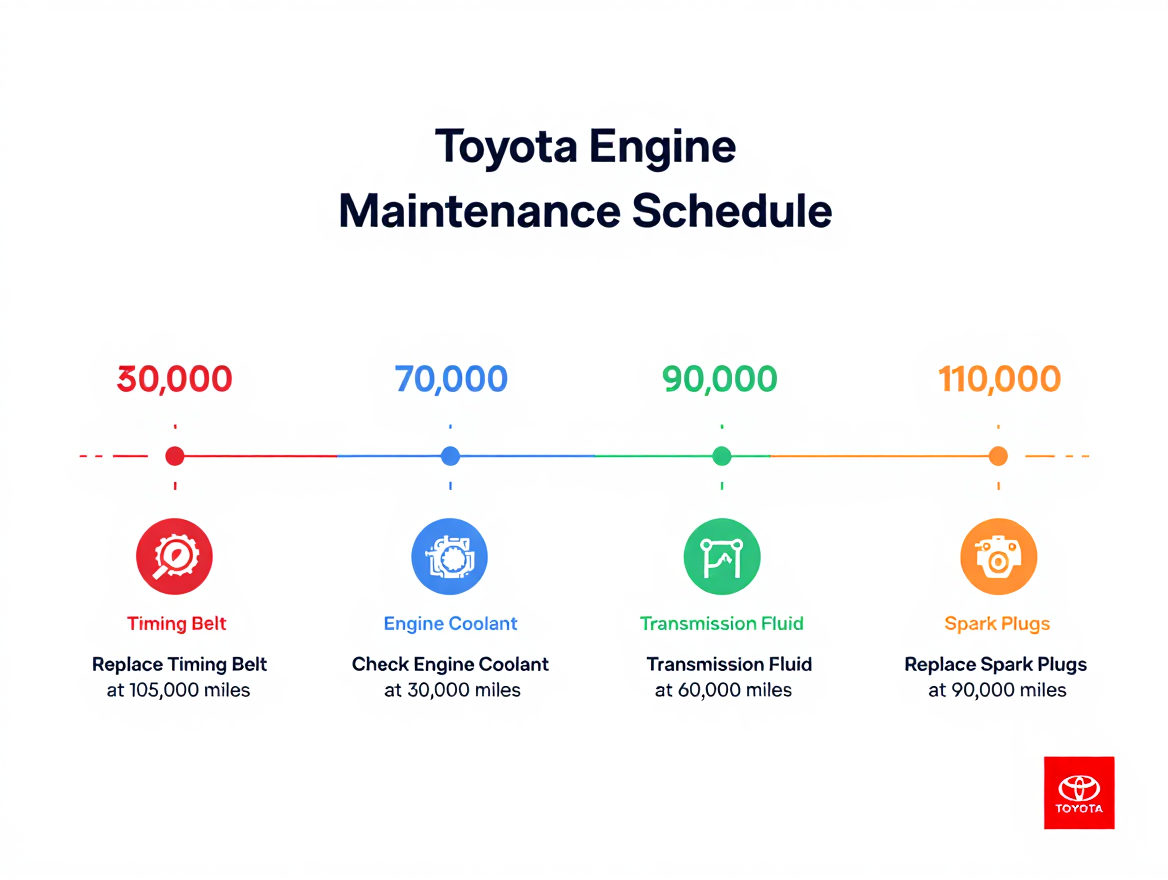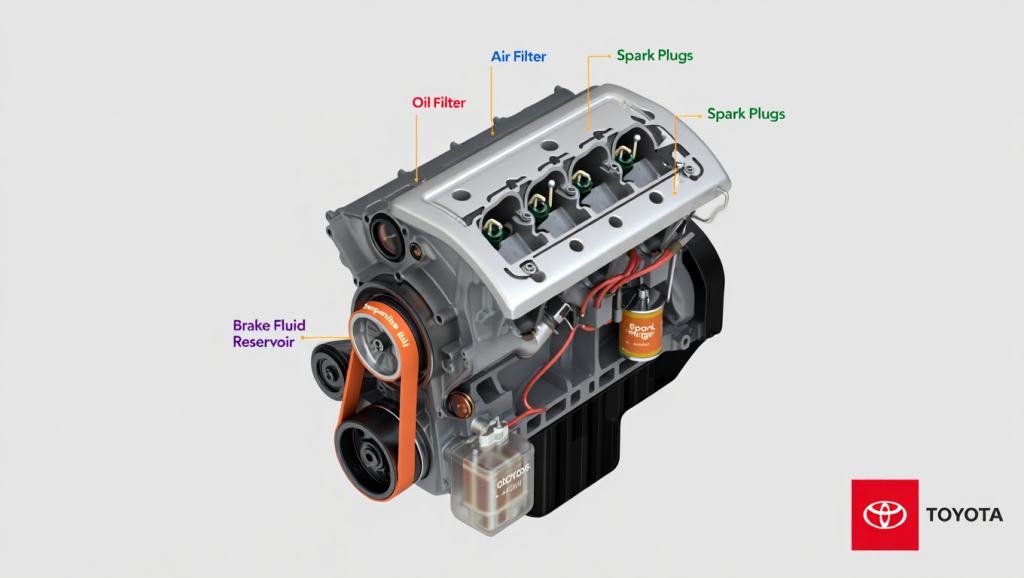Your Toyota’s engine is the heart of your vehicle. Keeping it in peak condition not only ensures smooth performance but also extends the life of your car and saves you from expensive repairs. From oil changes to belts, filters, and fluid checks, proper engine maintenance is essential for reliability, efficiency, and safety.
This guide provides practical tips for maintaining your Toyota engine, whether you drive a Corolla, Camry, RAV4, or Highlander. By following these practices, you can avoid common mistakes, reduce wear and tear, and keep your engine running like new for years.
Regular Oil Changes
Engine oil lubricates moving parts, reduces friction, and carries away heat and contaminants. Skipping oil changes can lead to overheating, increased wear, or even engine failure.
Recommended Oil Types and Intervals
- Synthetic Oil: Preferred for modern Toyotas. It withstands high temperatures, protects against sludge, and extends engine life.
- Conventional Oil: Suitable for older models but requires more frequent changes.
- Change Intervals: Most newer Toyotas recommend synthetic oil changes every 10,000 miles or 12 months, whichever comes first. Older models or severe driving conditions may require changes every 5,000–7,500 miles.
Signs Your Engine Needs an Oil Change
- Dark, dirty oil on the dipstick
- Engine noise or ticking
- Reduced fuel efficiency
- Illuminated oil warning light
DIY vs. Professional Oil Change
- DIY Pros: Cost-effective and convenient; allows you to check the oil filter and inspect for leaks.
- DIY Cons: Risk of incorrect oil type, overfilling, or improper disposal.
- Professional Service: Guarantees the correct oil type, proper disposal, and inspection of other engine components.
Example: A Camry owner in a cold region used synthetic oil and followed the 10,000-mile interval. The engine ran smoothly, no sludge buildup occurred, and fuel efficiency remained consistent.
Pro Tip: Always use Toyota-approved oil grades to maintain engine warranty and performance.
Air and Fuel Filter Maintenance
Clean air and fuel filters are vital for proper engine combustion and efficiency. Clogged filters can reduce power, increase fuel consumption, and strain engine components.
Air Filter Tips
- Function: Prevents dirt, dust, and debris from entering the engine.
- Replacement Interval: Every 15,000–30,000 miles, or more often in dusty environments.
- Signs of Clogging: Reduced acceleration, rough idling, and poor fuel economy.
Example: A RAV4 driven off-road noticed reduced power due to a clogged air filter. Replacing it restored engine responsiveness immediately.
Fuel Filter Tips
- Function: Filters contaminants in fuel before it reaches the engine.
- Replacement Interval: Typically every 30,000–50,000 miles, depending on fuel quality.
- Benefits: Prevents injector clogging, reduces rough idling, and maintains fuel efficiency.
Pro Tip: Always replace filters with OEM or high-quality aftermarket parts to ensure fit, performance, and engine protection.
Cooling System and Radiator Care
The cooling system prevents overheating, which can cause severe engine damage. Proper maintenance of coolant, radiators, and hoses ensures your Toyota engine stays within safe operating temperatures.
Checking Coolant Levels and Condition
- Coolant Type: Use Toyota-approved antifreeze/coolant to prevent corrosion and overheating.
- Frequency: Check coolant levels at least monthly. Inspect for leaks or discoloration.
- Signs of Problems: Low coolant, steam from under the hood, or engine overheating.
Radiator Maintenance Tips
- Flush and replace coolant according to the manufacturer’s schedule (usually every 50,000–100,000 miles).
- Inspect hoses for cracks or swelling. Replace worn hoses promptly.
- Ensure the radiator cap is secure; a faulty cap can cause pressure loss and overheating.
Example: A 2017 Corolla owner ignored coolant discoloration. The radiator developed minor leaks, which could have caused major engine damage. Replacing the coolant and hoses early prevented expensive repairs.
Pro Tip: Never open a hot radiator cap. Wait until the engine cools to avoid burns from pressurized coolant.

Early Warning Signs of Engine Issues
- Unusual Noises: Knocking, ticking, or grinding can indicate oil or internal engine problems.
- Reduced Performance: Hesitation during acceleration may indicate clogged filters or worn components.
- Warning Lights: Check engine, oil, or temperature lights should never be ignored.
Regular inspections combined with proper maintenance prevent minor issues from escalating into costly repairs.
Timing Belts and Serpentine Belts
Belts control essential engine functions. Worn or broken belts can cause severe damage, from overheating to complete engine failure. Understanding maintenance requirements is key.
Timing Belt Maintenance
- Function: Coordinates the movement of camshaft and crankshaft for precise engine timing.
- Replacement Interval: Usually every 60,000–100,000 miles, depending on Toyota model.
- Symptoms of Wear: Squealing noises, engine misfires, oil leaks near the timing cover.
Serpentine Belt Care
- Function: Powers alternator, water pump, power steering, and AC.
- Inspection Tips: Look for cracks, fraying, or glazing. Replace if any signs of wear appear.
- DIY Check: With the engine off, inspect each belt and feel for tension; loose belts should be adjusted or replaced.
Example: A Camry owner ignored a worn serpentine belt, leading to alternator failure. Replacing it on schedule could have avoided a $400 repair.
Pro Tip: Use OEM belts for guaranteed fit and durability. Cheap aftermarket belts may stretch or crack prematurely.
Spark Plugs and Ignition System
Spark plugs ignite the air-fuel mixture, ensuring smooth engine performance and fuel efficiency. Neglecting them reduces power and increases fuel consumption.
When to Replace Spark Plugs
- Toyota typically recommends every 60,000–100,000 miles for iridium or platinum plugs.
- Symptoms of worn plugs: rough idling, hesitation during acceleration, poor fuel economy, engine misfires.
Ignition Coil Maintenance
- Ignition coils deliver electricity to spark plugs.
- Faulty coils can cause misfires and engine stalling.
- OEM coils ensure proper fit and long-term reliability; avoid cheap aftermarket options.
Example: A RAV4 owner replaced spark plugs after 90,000 miles, restoring smooth acceleration and reducing fuel consumption by 1–2 MPG.
Pro Tip: Always replace spark plugs in sets, even if only one seems faulty, to maintain engine balance.
Fluids and Lubricants Beyond Oil
Several other fluids play a critical role in engine longevity and efficiency. Neglecting them can increase wear and lead to expensive repairs.
Transmission Fluid
- Automatic and CVT transmissions rely on clean fluid for smooth operation.
- Check levels regularly and replace per Toyota’s schedule (usually every 60,000–100,000 miles).
- Signs of issues: slipping gears, delayed engagement, unusual noises.
Brake and Power Steering Fluids
- Low or contaminated brake fluid can indirectly strain the engine under heavy braking.
- Power steering fluid ensures smooth steering and reduces engine load during turns.
- Replace fluids every 2–3 years or as recommended by Toyota.
Pro Tip: Always use Toyota-approved fluids. Mixing incompatible types can damage seals, pumps, and other components.
Common Mistakes Toyota Owners Make
Even reliable vehicles like Toyotas can suffer if owners neglect key maintenance tasks. Avoid these pitfalls to extend engine life.
- Skipping Oil Changes: Leads to sludge buildup and premature engine wear.
- Ignoring Warning Lights: Check engine or oil light should never be overlooked.
- Using Incorrect Fluids or Low-Quality Parts: Can void warranties and damage components.
- Aggressive Driving or Overloading: Adds unnecessary stress on engine and drivetrain.
Example: A Corolla owner using non-approved coolant experienced radiator corrosion, requiring a costly replacement.
Practical Tips for Extending Engine Life
Simple habits make a significant difference in engine longevity and performance.
- Warm Up the Engine in Cold Weather: Letting it idle for 30–60 seconds prevents thermal stress.
- Avoid Short, Frequent Trips: Short trips don’t allow the engine to reach optimal temperature, promoting condensation and sludge.
- Keep the Engine Bay Clean: Prevents corrosion and allows early detection of leaks or wear.
- Use OEM or High-Quality Aftermarket Parts: Ensures fit, performance, and long-term reliability.
- Regular Inspections: Monthly checks of belts, fluids, and hoses can prevent major repairs.
Example: A Highlander owner following these habits reported zero major engine repairs over 120,000 miles.
Final Thoughts
Maintaining your Toyota engine is the key to reliability, efficiency, and long-term performance. By focusing on: Oil Changes – Use the recommended type and interval. Filters – Keep air and fuel filters clean. Belts – Inspect and replace timing and serpentine belts. Spark Plugs and Ignition – Replace as needed. Other Fluids – Transmission, brake, and power steering fluids you can prevent costly repairs and enjoy smooth performance for years.
FAQs
How often should I change my Toyota engine oil?
Use synthetic oil every 10,000 miles or per your owner’s manual. Severe conditions may require changes every 5,000 miles.
Can I use aftermarket filters without issues?
High-quality aftermarket filters are acceptable, but cheap alternatives may reduce performance and cause engine wear. OEM filters are recommended for warranty compliance.
How do I know if my timing belt needs replacement?
Look for squealing noises, cracks, or oil leaks near the timing cover. Follow Toyota’s replacement schedule to prevent catastrophic failure.
What happens if I neglect coolant maintenance?
Overheating, engine warping, and corrosion can occur. Regular coolant checks prevent expensive engine damage.
Are hybrid Toyota engines maintained differently?
Yes. Hybrids require special attention to high-voltage batteries, regenerative braking systems, and inverter coolant, though oil and belt maintenance remain similar.

Benjamin Grey is an automotive engineer and writer at Car Parts Advisor. With years of experience in the automotive industry, he shares expert advice on car parts, maintenance, and repairs to help car owners keep their vehicles running smoothly.





